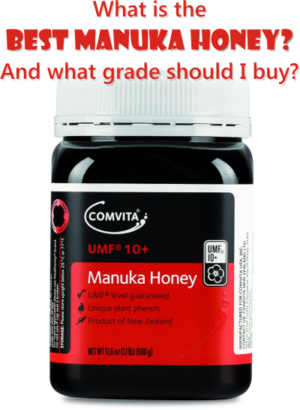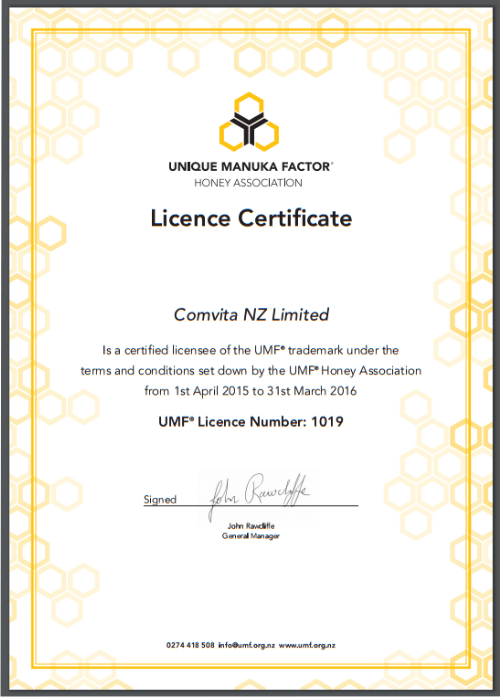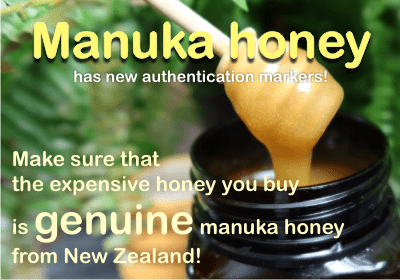Lots of people have asked me what is the best manuka honey? And what brand is more trustful to be selling genuine manuka honey from New Zealand. Here is a Comvita manuka honey review because statistics show this is the brand chosen by the majority of people.
First of all, why manuka? Because it tastes good and has medicinal properties, helping with digestive problems, throat and nose issues, skin conditions and helps in maintaining a strong healthy body.
Who is Comvita?
It’s the New Zealand leading producer of manuka honey. A company which started its business in 1974, in a small rural town named Paengaroa, surrounded by pollution-free forests of manuka trees. Besides manuka honey they sell other types of honey, mostly blends, but also propolis (even toothpaste with propolis), and olive leaf products.
At Comvita, manuka honey comes in jars with different grades on the label: UMF 5+, 10+, 15+, and 20+.
UMF5+ is the one recommended for daily consumption, as food and as medicine for prevention and support of a balanced and healthy body.
A 15+ UMF rating is highly active and medicinal. 10+ and 15+ are the best if you want to improve your health or you have some specific conditions you want to treat (leg ulcers for example).
20+ is highly therapeutic, used for very hard to heal wounds or burns.Available on Amazon. The ratings are very good and so are the reviews. There are lots of comments that can convince you of the quality of the products. I have gone through many of them and summarize the conclusions here.
Here are some of their products available on Amazon:
How trustful is Comvita?
From the people’s experiences with manuka honey from Comvita.
 Pros:
Pros:
– Comvita is New Zealand’s leading producer of Manuka Honey. The quality is remarkable.
– It is UMF certified. This grade, UMF followed by a number, guaranties the purity and quality of manuka honey. As opposed to jars that show only 1 chemical marker, namely the MGO content (on the label, there is this grade: MGO plus a numer), an UMF grade take into consideration 3 chemical markers: DHA, MGO, and Leptosperin.
– It’s delicious and has a unique flavor. At least after some people. Others say it’s a little bitter.
– It’s highly therapeutic. The reputation of manuka honey did not just show out from nothing. There are lots and lots of studies proving its antimicrobial, anti-inflammatory, wound and sunburn healing, antioxidant and radical scavenging activities. Amazing results on both people and pets.
Read more: Is manuka honey a natural treatment for MRSA? Is it the best?
Manuka honey – THE BEST to treat wounds, burns, skin infections.
 Cons:
Cons:
• It comes in plastic bottles. Probably for safety reasons during transit. (That plastic, polypropylene (PP) is stable at high temperatures, up to 220 °F (104 °C), is autoclavable and can be steam sterilized. This type of PP jars are used for filing at high temperatures – not that this is the case with honey, as it is raw, unheated. PP has excellent chemical resistance.)
• It’s expensive. As a rule, compared to other honeys, manuka honey is expensive because:
– it’s antimicrobial (some countries such as Australia and New Zealand even call them “therapeutic goods”)
– it’s delicious
– the demand is high and continually growing.
It is probably more expensive that manuka honey from other brands due to its high quality and appreciation. Somebody even said “it costs an arm and a leg, but I love it.”
In New Zealand you may even find jars more expensive than on Amazon, or other shops from the continent. This is explained by the raise in price due to a bad 2016 honey season. Find all the details in 2017 brings bad news for manuka honey lovers!
• The jars are not full to the brim. There are customers complaining about the jars being only 3/4 full.
What grade shall I buy?
For wounds and burns, Ken Allen, managing director of a firm which makes wound dressings impregnated with manuka honey, says that we don’t need to worry about how potent the honey is: “It doesn’t have to have a high rating. Even one as low as UMF 10 can heal leg ulcers. So, if you want only a gentle antiseptic, the lower rating of either UMF or MGO should do the trick. Manuka with a UMF rating that’s too high (19 or over) can cause burning or stinging. The most therapeutic range appears to be between 16-18. You can use this UMF amount safely.”
If you are searching for manuka honey it means you don’t necessarily have ran out of honey for breakfast, but that you want a therapeutic honey. For this I recommend UMF10+ or UMF15+.
We cannot trust them by word, but we can get an idea looking at their certifications and listening to people’s experiences with their products.
Grades?
If you need help in understanding the grades of manuka honey, here are 2 articles on the subject:
• I want to buy manuka honey. What is UMF 16+, MGO 400+, Active?
• Deciphering manuka honey: UMF15+, MGO400, 24+ Bio Active, KFactor16, TA. And LOTS OF FRAUDS.
Comvita’s certifications:
1. UMF Honey Association Licensee no. 1019
– Perhaps the most important of all, representing a guaranty that manuka honey is genuine, well tested and the UMF factor shows exactly the antimicrobial power of the product.
-The UMF® trademark is a quality trademark that is internationally verified and recognised.
– It is backed by a quality standard, independent audits and a network of accredited laboratories around the world.
2. HACCP Certified (Certificate No: HCV21212 and FSAU13/8403)
HACCP stands for Hazard Analysis and Critical Control Points. This is a preventative Food Safety System in which potential hazards are, identified and appropriate control measures are taken before any problems can occur.
Comvita operates under a certified Food Safety Management System which complies with CAC HACCPVER:2003 – CODEX HACCP (Hazard Analysis and Critical Control Point ) and GMP (Good Manufacturing Practices) for the production, packing and distribution of Mixed Flora and UMF® certified Honey (Manuka Honey).
3. New Zealand Ministry of Health GMP Certificate
This certification recognizes that Comvita has robust systems to ensure the safety and efficiency therapeutic goods. In Australia some Comvita products, such as manuka honey UMF 10+ and above, are classified as Therapeutic Goods.
4. Comvita is registered as an Exporter with the Ministry for Primary Industries. New Zealand Exporters need to be registered to be able to apply for official assurances (export certificates).
5. Comvita has a Risk Management Programme (RPM) which is registered and verified by the New Zealand Ministry for Primary Industries. RMP is a written programme designed to manage hazards, wholesomeness and labeling of animal material and products. This ensures that the products are ‘fit for purpose’ – safe, suitable and truthfully labelled.
6. TGA verified Certificate of GMP Compliance as a Manufacturer
This certifies that COmvita is verified to have robust systems in place to meet the PIC/S Guide.
with Comvita, “you can be sure that you are buying the best quality Manuka honey and your rights as a consumer are protected.” (Comvita)
Other Comvita recommendations:
The manuka honey purchased in a jar is for oral/internal use only, it is not a sterile honey. if you want to use it for difficult wounds, it is better to use a medical grade honey, like medihoney. Also, if you want to use it for the skin, the producer recommends to use it only on spots and not on the entire face.There are special creams for this, more fit for the entire complexion.
When applying it on these spots, you may experience a little itching for a short period of time.
If you are trying manuka honey for the first time, start with very small amounts and increase in time. It is considered medicine, so be careful.
The jars have expiration date. Why?
An expiration date doesn’t mean the product is spoiled and you should throw it in the garbage bin. Food regulations impose every producer to establish an expiration date and print it on the jar.
Honey doesn’t spoil. I’m sure you have heard about the honey found in Tutankhamen’s tomb, dating back approximately 3,000 years, which is the world’s oldest sample of honey and still perfectly edible. In such a long time, things happen in honey too, but will not spoiled.
The first thing that happens is that it crystallizes. But this is a natural process, not altering with anything the qualities of honey. This crystallization is often a good method of knowing you have real raw honey, not an adultered or a highly processed honey. An over-processed honey – what we find on the shelves of supermarkets have all been processed, to prolong their long life, to prevent them from crystallization and make them look beautiful for longer periods of time. (You can read this to understand why and how it is processed: What is processed honey?)
To bring the honey back to its liquid state, all you need to do is warm it a little (till it reaches the temperature of your body) in a bain marie pot.
Another thing that may happen is to change its composition. Some enzymes may disappear, some may increase. And content of MGO will suffer changes, it modifies it in time. It may increase and then decrease a little, but not under the initial content specified on the jar.
! The expiration date can help you with one thing. It can tell you how fresh the honey is. If we are now in 2017 and the expiration date is in 2018, it means the honey was bottled in 2016, meaning it is 1 year old, not that fresh. If the expiration date is in 2019, then you have a fresh honey, harvested in 2017.
Remember that we are different.
It is impossible for us to ALL like the taste of manuka honey.
It is also impossible to heal everybody, as our bodies are so complex and even if our main disease is the same, the other underlying factors, conditions, genes, predispositions and so on, are different. The effects of manuka honey might also be different. Even skin conditions may react differently.
But as a rule, because we need a reliable starting point, we look at what the majority of people have already experienced. And for Comvita manuka honey people have given a lot of stars in their reviews. This tells us a lot.
And if you don’t like Comvita, still don’t give up on manuka honey. Other people that have been disappointed with the price and quantity, have discovered other brands of manuka honey, that fit their standards. Like Melora, or Tahi, or so many others that are UMF certified. Here is a list of certified UMF manuka honey producers.
And if you have found that manuka honey is not on your taste, remember that your local raw honey is absolutely amazing, too. Don’t underestimate it!
=================
==================






